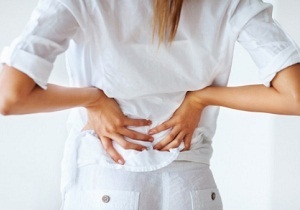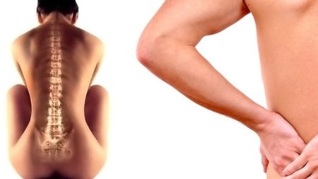According to the statistics, 70% to 80% of the population of our country, at least once in life in order to cope with the pain in the back, in the lumbar region, or, medically speaking, pain in the lower back. Its prevalence in the Uk is 59%, in Denmark — 70%, Finland — 75%. Among all the has issued a "hospital" in our third country in the case of back pain.

The causes of low back pain can be the most various — from the psychogenic factors in the metastasis of cancer. Fortunately, the serious problems of the pathology does not represent more than 5% of cases of low back pain, the main cause is a power surge or a spasm of the muscles, as well as other musculoskeletal problems.
Types of back pain, the lumbar region
The pain in the back, as in any other organ, various. Most often it is precisely the nature of the pain — the first sign by which the doctor can make a hypothesis on the nature of the disease.
According to the origin of the pain in the back can be:
- primary — caused by chronic diseases, functional or degenerative changes in the tissues of the spine and muscles, sometimes with the participation of neighbouring structures and roots of the spinal nerves.
- secondary — caused by injury, inflammation, arthritis, or osteoarthritis intervertebral, joints, the defeat of the internal organs.
The duration of the pain can be:
- acute — occurs because of the new damage or new arisen of the pathological state, is intimately associated with it, lasts up to 6 weeks;
- podostraya — lasts 6 to 12 weeks;
- chronic — lasting more than 12 weeks.
The clinical manifestations typical will depend on the source of the pain.
Disorders musculo-tonic and other pain syndromes
Hypothermia, the constant uncomfortable posture during the holidays or the work, the poor motor skills of stereotypes, degenerative diseases of the spine, alter the height and elasticity of intervertebral discs, lead to the load on the muscles is distributed unevenly. Some of them are constantly overloaded, some, on the contrary, do not receive support. Accordingly, in some muscles begins with a spasm, causing the pain. So-called trigger points, the impact on which strengthens the spasm and the pain. Characteristics characteristics of the pain:
- clearly limited the area of the plot (the local pain);
- the felt in the depth of the muscle layer;
- palpation of the muscle tight tight site or tyazh, in which appear especially a sore point;
- upon exposure to these pain points, strong increase, forcing the patient to grimace (a symptom of jump);
- the limitations of the mobility;
- if you can stretch the muscle the pain subsides.
It is on this kind of pain is acting ointments that heat up or the devices. Of course, the effect is of short duration, because the cause which causes a spasm of the muscles, they do not eliminate. A more reliable method — the injection of a drug anesthetic directly into the trigger point, and kinesiotherapy, physiotherapy, manual therapy.
The Compression neuralgia
Caused by compression of the blood vessels or stretching of the roots of the spinal nerves due to disc herniation or reduce its height and, accordingly, the distance between the vertebrae. This kind of pain is often felt as a "surface", which is poured out rather in the skin than in the depth of the tissue. It is strongly enhanced by the sneezing, the coughing, the load on the spine. It is such a pain is felt as a classic "lumbago", used in the course of the nerve root.
Stenosis of the spinal canal
Occurs because of a herniated disc, protrusion (rough) of the party in the vertebral canal, or the appearance of third — party chipped off of the disk. Anyway compressed of education under the name of "tail of horse" — the stem of the lowest of the spinal nerves Innervate the lower limbs. The pain when it spreads along the course of the nerve root, from waist to foot, appears at rest and during walking, enhanced by the extension of the spine and decreases when it is tilted forward.
Particular the syndrome
Called with the pathology of the small intervertebral (facet) joints. The pain may be local, as well as radiate (give) to the groin, tailbone, at the back of the thigh. Amplified by the bending and rotation in the back.
All of these types of pain syndrome appear suddenly, sometimes, the patient may even say, in this day and the day after exposure (raised something, is not also turned etc). The pain increases in the evening and after exercise, and decreases after resting. In addition to this kind of pain is typical for people in middle age and older.

Inflammatory pain
Caused by inflammatory lesions of the joints of the spine — the various types of arthritis: rheumatoid arthritis, Reiter's disease, ankylosing spondylitis, etc Inflammatory the pain occurs most often in young people, develops gradually. It is maximum at the beginning of the day and decreases at night or after a physical effort. Often accompanied by the morning line.
Other possible causes of low back pain pathology of the internal organs, for example kidney disease or inflammation of the epididymis in women. As many diseases can manifest themselves in the same way, at least in relation to the pain syndrome, it is best not to make the diagnosis the more and contact your doctor.
The solicitation of the advice of a specialist is required in the following cases:
- the pain started after trauma, especially in older women;
- a history of a cancer;
- the pain is accompanied by an increase of the temperature;
- suddenly, and without apparent reason, weight decrease;
- change the approach to or subtracted from the leg;
- there are difficulties in urination and defecation.
These signs may be manifestations of more serious diseases that require immediate treatment.
The diagnosis of the pathology
When the pain in the back and the lumbar region doctor first of all, you need to exclude the life-threatening the state — fortunately, they are quite rare.
General and biochemical analysis of blood may identify the inflammatory changes, to detect a high level of calcium, which is characteristic for the metastasis of malignant tumors in the bone structure, the change in the number of blood cells in the myeloma of the disease, and so on. Older men may affect the analysis of the prostate-specific antigen to avoid cancer of the prostate.
X-ray examination detects the change of the height of the intervertebral discs, possible osteophytes — bony proliferation caused by the poorly distributed load on the vertebrae, the change in form-same vertebrae.
The ct scan and MRI will show bulging of the intervertebral disc, calcification areas (calcification), stenosis of the spinal canal.
Today, on the change of these two studies comes gradually to an ULTRASOUND of the spine, allowing the detection of similar changes, without exposing the patient to excessive load of the radiotherapy.
Mandatory consultation with a neurologist, according to the testimony — a chiropractor.
After a full inspection is understandable treatment strategy. Generally, to cope with the pain in the lumbar, you can the therapeutic methods, the operation is shown to be relatively rare.
The drug treatment of pain in the lumbar region of the back
In 95% of cases, the patient has no reasons to worry — usually the pain in the back is not a threat to the health and may be treatable. Myofascial syndrome adjusted the fastest to solve the root of the pain may take several months. One way or another, in most cases, there is a need for drug therapy. Use of nonsteroidal anti-inflammatory drugs (NSAIDS) to relieve pain and reduce swelling, medications for the maintenance of cartilage conjugation. Sometimes, to reduce the pain and swelling are prescribed and hormonal drugs — they act more quickly non-steroidal anti-inflammatory drugs, they are administered in the form of blockade and the dropper under the supervision of a doctor.
The drugs may be in the form of ointments and gels this method of treatment of pain in the lower back of popular advertising. But as the method of introduction into the organism of an active substance is the use of the outdoor facilities — the ineffective, which we can provide, in effect, the greater part of the same does not penetrate through the skin.
Another popular method — the oral intake of medicines, or, more simply, of tablets and capsules. Drinking a pill is easy, the effect occurs quite quickly, usually within half an hour-an hour, but long-term taking medicines may have an impact on the condition of the gastro-intestinal tract.
Therefore, the fastest and effective way to relieve the pain of injections directly into the muscle or the affected area on the back, so-called blockade. Their only drawback — the strict requirement of high qualification of the doctor who will perform this manipulation.
Non-drug therapy
Generally, a drug therapy is supplemented by non-drug methods. What kine need, decides to doctor. It may be classic, the massage or manual therapy, and osteopathy of the procedure, as well as acupuncture. Gaining popularity and physiotherapy — gymnastics special activities special decompression simulators, which help to relieve tense muscles, to train new drivers stereotypes, thus eliminating the cause of the pain in the back.

So, the best option of therapy of the pain in the back — a combination of drugs and methods non-drug of the approach. Such integrated to work in multiple directions allows you to quickly cope with the disease, to get rid of the pain or to obtain a lasting effect.


























